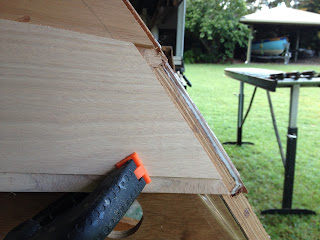Over the last few months I have been rowing my Acorn 15 regularly because I enjoy it and I need the exercise. My Acorn 15 rowing boat has a fixed rowing position and I decided that it would be a good idea to try rowing with a sliding seat to get a more complete workout. One option would have been to modify the Acorn 15 by fitting a sliding seat. I wasn't keen on doing this because I didn't want to spoil the look of the Acorn 15. It would also have been a compromise solution.
While these ideas were going round in my head I came across the photo below taken by my friend and fellow member of the Wooden Boat Association of Queensland Ian Primrose.
The photo is of a Classic Derwent Skiff designed by Allan Witt of a company called Row and Sail based in Tasmania.
I liked the appearance of this boat which is configured with a sliding seat as shown. The rowing position can be moved forward and an additional seat added for a passenger if desired.
This version of the Derwent Skiff is 5.5 metres (18 feet) long and should weigh around 38 kg. This is less than half the weight of my Acorn 15.

Monday, 26 March 2018
Planking Complete
On the middle plank on the other side of the boat I managed to cut the two scarfs on the same side of the centre section. I had already cut the scarfs on the fore and aft sections so I had to cut the incorrect scarf off and make a new one. Cutting the scarf off lost 50mm of the plan's length; the new scarf effectively lost another 50mm. The planks in the kit are cut with some extra lengths to allow a damaged scarf to be recut but doing this would only lose part of the scarfs 50mm length. The result of this is shown here.
The only way to recover from this blunder was to and an extension to the end of the bow section. This resulted in two scarf joints being close together. This is another nail in the coffin of the varnished boat idea and I will now paint the outside of the boat.
In this next phot the C clamps are clearly visible as are some home made screw clamps where the C clamps can't be used because there isn't enough clearance between the hull and the mold.There are also a couple of good old metal screw clamps in there and a couple of V clamps holding the planks to the stem. These V clamps simply hold by friction but only work on a shallow angle.
Here's the fully planked hull.
at this point I removed all the temporary screws holding the keel, inner stem and transom to the mold and tried to lift the hull off the mold. It wasn't easy because the squeezed out epoxy inside the hull was sticking to the sticky tape and plastic which was in turn stuck to the mold. Fortunately the protective layer of tape and plastic had done its job and I was able to lift the hull up.
While waiting for the planking glue to go off I have assembled the "buoyancy tank". This is a trapezoidal shaped box which sits on the keel in the middle of the boat with the sliding seat mounted on top of it and the outrigger arms attached to the aft end of the box. The top, bottom and ends have corner strips glued to them and finally the sides are glued on. In this photo the sides are being glued in place - a tricky clamping exercise to hold the ends of the side panels down. The tape was sufficient to pull the joints together along the long edges.
After cleaning up the box I couldn't resist a test assembly of the box, the outrigger arms and the sliding seat. Now this weird shaped box begins to make more sense. there is auite a bit more work to be done on this assembly and I will do that while waiting for the epxoy to set on the outer keel, cutwater and skeg.
Gone to a New Home.
Sadly I have parted with my Derwent Skiff. I loved the feeling of flying over the water that came with the long oars and sliding seat but t...

-
Here is that last photo of the build process. The boat is sitting on the trailer that was built for my Acorn 15. The boat is supported by th...
-
Sadly I have parted with my Derwent Skiff. I loved the feeling of flying over the water that came with the long oars and sliding seat but t...
-
It has been a week since the last post, quite a lot of time spent int he boat shed and my shoulders ache from hand planing! There doesn'...









No comments:
Post a Comment